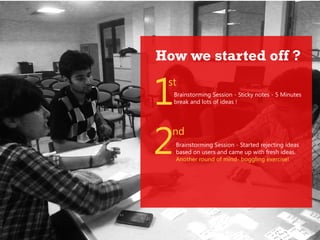Adolescent Girls Healthcare Project | IIT Guwahati
- 1. How we started off ? 1 2 st Brainstorming Session - Sticky notes - 5 Minutes break and lots of ideas ! nd Brainstorming Session - Started rejecting ideas based on users and came up with fresh ideas. Another round of mind- boggling exercise!
- 2. initial ideas To aid and simplify the learning and communication (so that it becomes easy for them to express their ideas) for deaf and dumb To enhance the learning experience of school-going kids (in the school environment) (3-8yrs) To motivate kids to move out of the digital environment and interact with the physical surroundings (7-12 years)
- 3. but what we wanted ? Healthcare Easily available users Rural Assam Social Cause Wanted Field Research Need based Problem oriented
- 4. we finally decided ? To make Adolescent girls (11-18yrs) aware of health and hygiene (physical, psychological and hormonal) related issues during puberty.
- 5. literature review We did literature study to get familiar with the problem that girls face in rural assam during adolescence and also understand the cultural dimensions of the place. We read research papers on study of maternity issues in assam - (http://online.assam.gov.in/documents/218378/2d2df305-bfd4-46f5-86aa-10fcec046fa7) government schemes like Kishori Shakti Yojna http://socialwelfareassam.com/Guidelines.asp?Page=1&wPageType=KSY r medical blogs - http://icresd.page.tl/abstracts.htm
- 6. user research - phase 1
- 7. 1 2 3 4 Got to know about the detailed structure of PHC (Primary Health Centre. Culture was completely different from what we had thought. About population. About different schemes in schools regarding adolescent girls.
- 8. structure PHC (Primary Health Centre) Sub Centres ASHA (Accredited Social Health Activist) The basic structural and functional unit of the public health services. Manages the ANM and MPW workers and conduct various sessions and visits according to a weekly plan Works at grass root level. She is the main point of contact for health related issues
- 9. user research - phase 2
- 10. 1 2 3 4 Main work at sub-centre is Ī«DocumentationĪ». Auxillary Nurse Midwives (ANM) and Multi-Purpose workers (MPW) sit at the sub-centres. Sub-centres are basically set up for pregnant women, and not much work is related to adolescent girls is done. ANMs donĪ»t have much work. All the ground work is done by ASHAs.
- 11. role of sub-centre Pregnant ladies visit sub-centres, if they face any problem So, if the problem is basic like anaemia, white discharge etc. - ANMs provide them these tablets. Sub-centres have basic medicines like iodine tablets, iron tablets & metrogel tablets. If case is severe, then they are referred to PHC
- 12. user research - phase 3
- 13. 1 2 3 4 We went on to meet an ASHA in Kating Pahad, outside IIT Guwahati main gate. Her name was Saraswati Sarkar. Work primarily for pregnant women. PHC takes advantage of the strong network of ASHA, to also work for adolescent girls. ASHA is extremely loaded with work. Maintaining documents is a big task
- 14. 5 6 7 8 Survey. Field visit. Documentation. No salary. Met and interviewed three adolescent girls. Shy. Not confident. Ignorant
- 15. adolescent girls meeting - Not open and comfortable. No knowlege about puberty prior to reaching it. - Unaware of the basic health and hygiene related to this. Even ASHA is not trained for this - Unaware importance of nutritious diet, and what sorts of problems could occur during menstruation. - DonĪ»t attend the programs which are organized by ANMs, ASHAs and Anganwadi to make them aware of this issue. - Use clothes instead of sanitary napkins. AG 1 Age: 15 Non-Schooling AG 2 Age: 13 School going (6th) AG 3 Age: 14 School going (7th)
- 16. role of ASHA Conduct Meetings (alongwith ANMs/Doctors/Teachers) Immunization of Children Knowlege to Women & Girls Encourage Community Facilitate Access to Services Refer & Escort to PHC/SC/AW General Assistance Household Hygiene Construction of Toilets Primary Hub for Any Health Demands of Deprived People Time to Time Check Check-ups of Pregnant Women Supplementary Nutrition Sanitation of Pregnant Women Essential Provisions ORS, Iron Tablets Disposable Delivery Kits (DDK) Oral Pills & Condoms Sanitary Pads Counselling of Women Birth preparedness Safe delivery Breast-feeding Contraception Infections
- 17. opportunity areas Workload on ASHA . Something to assist them in their work System is too dependent on ASHA A dedicated system similar to ASHA for adolescent girls Reducing the paperwork for ASHA/ANM.


















